#colonial Art
Text
For #InternationalTigerDay + #MetalMonday:


Tiger-Headed Mace of Office
Deccan, India, late 18th century
Silver, gold, garnets, stone
L 77.3 cm, 2.7 kg
The Wallace Collection OA1760
“This beautifully-wrought silver-gilt tiger-headed mace, one of a pair, was intended not as a weapon but was employed purely for processional use, being carried by harbingers to herald the imminent approach of a prince, nobleman or important official. The tiger’s eyes are made of garnets and a green stone is mounted in the centre of the forehead. Although appearing to be of massive and deadly weight, such maces were usually hollow, made out of thin sheet-silver, embossed, chased, engraved and parcel-gilt. The hollow shell was filled with pitch, or a similar substance, to confer a degree of strength and rigidity. Similar examples bearing different animal’s heads (horses, bulls or elephants, for example) are also known.”
#animals in art#animal holiday#Indian art#South Asian art#Asian art#arms and armor#mace#tiger#metalwork#silver#gold#precious stones#Metal Monday#International Tiger Day#Wallace Collection#colonial art
90 notes
·
View notes
Photo
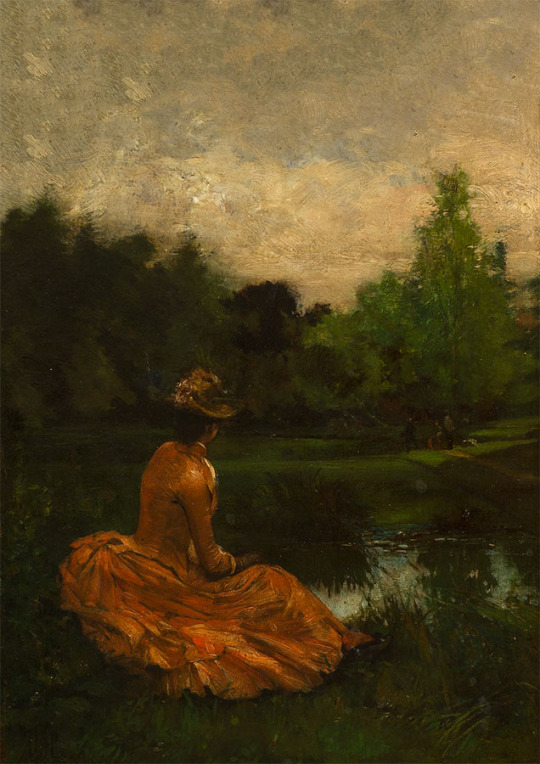
Guillermo Collazo (Cuban-born Spanish, 1850-1896)
A orillas del lago, 19th century
Colonial art, Museo Nacional de Bellas Artes de Cuba
Collazo was born into an established colonial family in Cuba. He went to live in New York for a while, where he found work in the studios of Napoleon Sarony, saving enough money to open his own art studio and enjoying great success as a portrait painter. In 1883 he returned to Cuba, opening a studio in Havana, and five years later he decided to go to Paris, where he opened a large studio which became a meeting point for the Cuban exile community. He died in Paris, and in 1899, his family brought his remains back to Cuba.
#art#art history#colonial art#colonies#west indies#spanish art#cuban art#european art#fine art#fine arts#female portrait#1800s#cuban exile#oil painting#a orillas del lago#portrait of a lady#woman#women in art#cuba#cuban#spanish#europe#europa#paris#france#new york#hispanic#latin#hispanola
143 notes
·
View notes
Text
Carved 1700's face with closed eyes.

An unusual 1790's engraving on a VT. grave, a face with closed eyes, feeling very alien. Sometimes skilled carvers would travel through a large region , or else a local craftsman would decorate the slate marker as needed as a side hustle, with varied skill levels! Of course this is after 225 years of weather.
2 notes
·
View notes
Text
17/12/23 this masterlist has been completely revamped with free access to all material. It will be updated and edited periodically so please click on my username and reblog the current version directly from me if you're able.
14/8/24 reboosting this post with How to Help Palestine updated. Please scroll to the bottom to donate or boost the links.
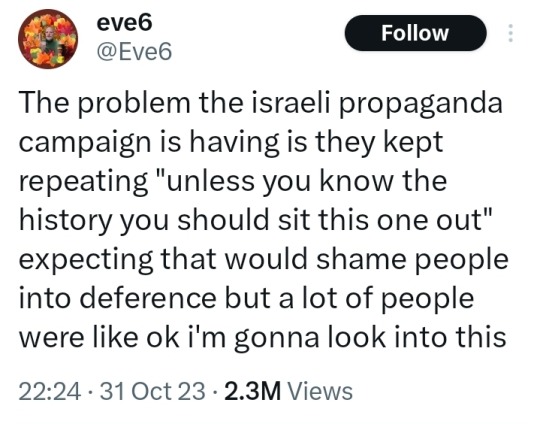
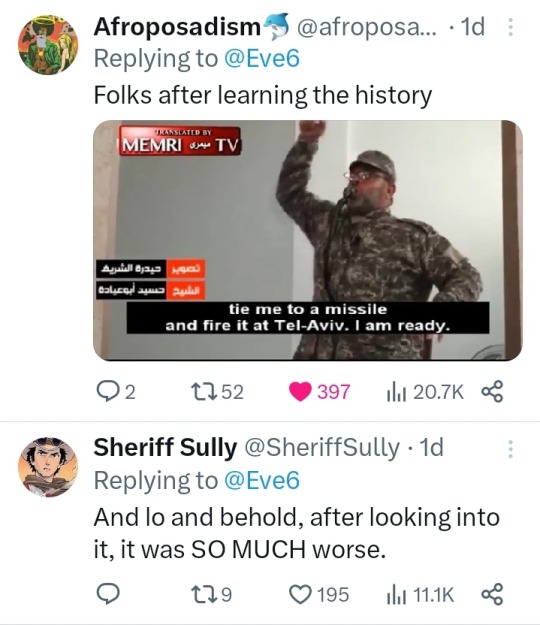

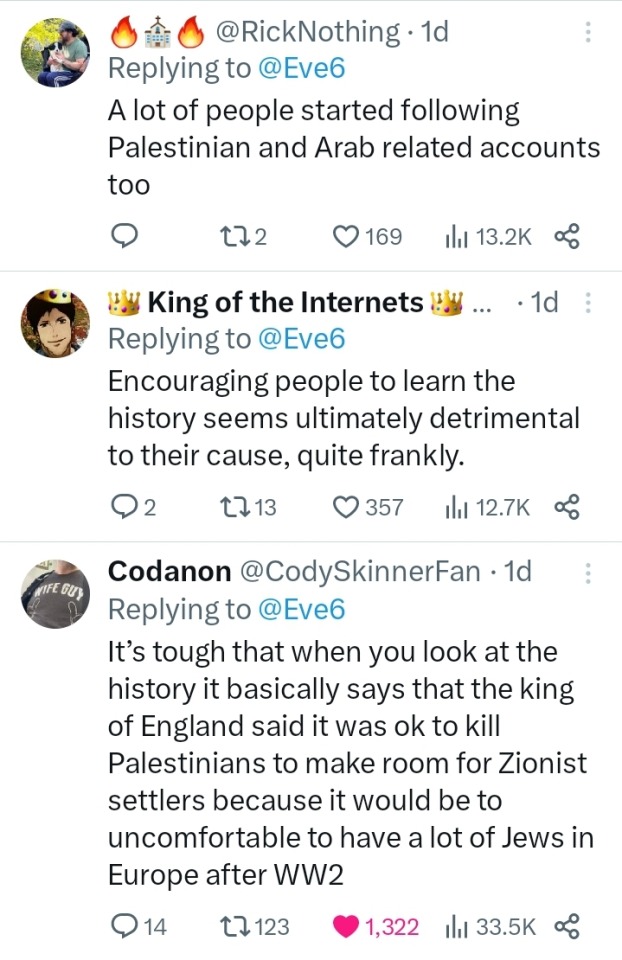
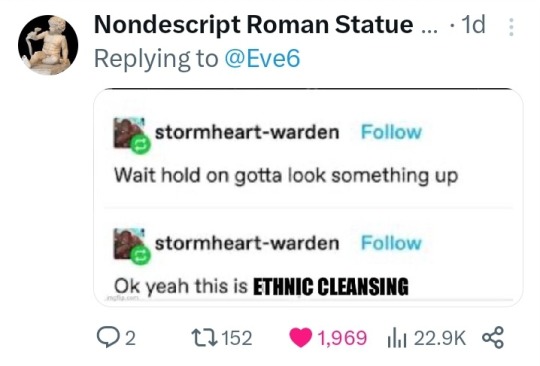
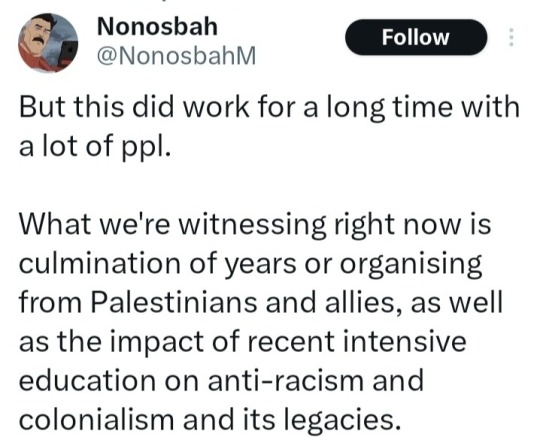
The Big Damn List Of Stuff They Said You Didn't Know
(Yes, it's a lot. Just choose your preferred medium and then pick one.)
Podcasts
Backgrounders and Quick Facts
Interactive Maps
Teach-Out Resources
Reading Material (free)
Films and Documentaries (free)
Non-Governmental Organizations
Social Media
How You Can Help <- URGENT!!!
Podcasts
Cocktails & Capitalism: The Story of Palestine Part 1, Part 3
It Could Happen Here: The Cheapest Land is Bought with Blood, Part 2, The Balfour Declaration
Citations Needed: Media narratives and consent manufacturing around Israel-Palestine and the Gaza Siege
The Deprogram: Free Palestine, ft. decolonizatepalestine.com.
Backgrounders and Quick Facts
The Palestine Academy: Palestine 101
Institute for Middle East Understanding: Explainers and Quick Facts
Interactive Maps
Visualizing Palestine
Teach-Out Resources
1) Cambridge UCU and Pal Society
Palestine 101
Intro to Palestine Film + Art + Literature
Resources for Organising and Facilitating)
2) The Jadaliya YouTube Channel of the Arab Studies Institute
Gaza in Context Teach-in series
War on Palestine podcast
Updates and Discussions of news with co-editors Noura Erakat and Mouin Rabbani.
3) The Palestine Directory
History (virtual tours, digital archives, The Palestine Oral History Project, Documenting Palestine, Queering Palestine)
Cultural History (Palestine Open Maps, Overdue Books Zine, Palestine Poster Project)
Contemporary Voices in the Arts
Get Involved: NGOs and campaigns to help and support.
3) PalQuest Interactive Encyclopedia of the Palestine Question.
4) The Palestine Remix by Al Jazeera
Books and Articles
Free reading material
My Gdrive of Palestine/Decolonization Literature (nearly all the books recommended below + books from other recommended lists)
Five free eBooks by Verso
Three Free eBooks on Palestine by Haymarket
LGBT Activist Scott Long's Google Drive of Palestine Freedom Struggle Resources
Recommended Reading List
Academic Books
Edward Said (1979) The Question of Palestine, Random House
Ilan Pappé (2002)(ed) The Israel/Palestine Question, Routledge
Ilan Pappé (2006) The Ethnic Cleansing of Palestine, OneWorld Publications
Ilan Pappé (2011) The Forgotten Palestinians: A History of the Palestinians in Israel, Yale University Press
Ilan Pappé (2015) The Idea of Israel: A History of Power and Knowledge, Verso Books
Ilan Pappé (2017) The Biggest Prison On Earth: A History Of The Occupied Territories, OneWorld Publications
Ilan Pappé (2022) A History of Modern Palestine, Cambridge University Press
Rosemary Sayigh (2007) The Palestinians: From Peasants to Revolutionaries, Bloomsbury
Andrew Ross (2019) Stone Men: the Palestinians who Built Israel, Verso Books
Rashid Khalidi (2020) The Hundred Years’ War on Palestine: A History of Settler Colonialism and Resistance 1917–2017
Ariella Azoulay (2011) From Palestine to Israel: A Photographic Record of Destruction and State Formation, 1947-1950, Pluto Press
Ariella Azoulay and Adi Ophir (2012) The One-State Condition: Occupation and Democracy in Israel/Palestine, Stanford University Press.
Jeff Halper (2010) An Israeli in Palestine: Resisting Dispossession, Redeeming Israel, Pluto Press
Jeff Halper (2015) War Against the People: Israel, the Palestinians and Global Pacification
Jeff Halper (2021) Decolonizing Israel, Liberating Palestine: Zionism, Settler Colonialism, and the Case for One Democratic State, Pluto Press
Anthony Loewenstein (2023) The Palestine Laboratory: How Israel exports the Technology of Occupation around the World
Noura Erakat (2019) Justice for Some: Law and the Question of Palestine, Stanford University Press
Neve Gordon (2008) Israel’s Occupation, University of California Press
Joseph Massad (2006) The Persistence of the Palestinian Question: Essays on Zionism and the Palestinians, Routledge
Memoirs
Edward Said (1986) After the Last Sky: Palestine Lives, Columbia University PEdward Saidress
Edward Said (2000) Out of Place; A Memoir, First Vintage Books
Mourid Barghouti (2005) I saw Ramallah, Bloomsbury
Hatim Kanaaneh (2008) A Doctor in Galilee: The Life and Struggle of a Palestinian in Israel, Pluto Press
Raja Shehadeh (2008) Palestinian Walks: Into a Vanishing Landscape, Profile Books
Ghada Karmi (2009) In Search of Fatima: A Palestinian Story, Verso Books
Vittorio Arrigoni (2010) Gaza Stay Human, Kube Publishing
Ramzy Baroud (2010) My Father Was a Freedom Fighter: Gaza's Untold Story, Pluto Press
Izzeldin Abuelaish (2011) I Shall Not Hate: A Gaza Doctor’s Journey on the Road to Peace and Human Dignity, Bloomsbury
Atef Abu Saif (2015) The Drone Eats with Me: A Gaza Diary, Beacon Press
Anthologies
Voices from Gaza - Insaniyyat (The Society of Palestinian Anthropologists)
Letters From Gaza • Protean Magazine
Salma Khadra Jayyusi (1992) Anthology of Modern Palestinian Literature, Columbia University Press
ASHTAR Theatre (2010) The Gaza Monologues
Refaat Alreer (ed) (2014) Gaza Writes Back, Just World Books
Refaat Alreer, Laila El-Haddad (eds) (2015) Gaza Unsilenced, Just World Books
Cate Malek and Mateo Hoke (eds)(2015) Palestine Speaks: Narrative of Life under Occupation, Verso Books
Jehad Abusalim, Jennifer Bing (eds) (2022) Light in Gaza: Writings Born of Fire, Haymarket Books
Short Story Collections
Ghassan Kanafani, Hilary Kilpatrick (trans) (1968) Men in the Sun and Other Palestinian Stories, Lynne Rienner Publishers
Ghassan Kanafani, Barbara Harlow, Karen E. Riley (trans) (2000) Palestine’s Children: Returning to Haifa and Other Stories, Lynne Rienner Publishers
Atef Abu Saif (2014) The Book of Gaza: A City in Short Fiction, Comma Press
Samira Azzam, Ranya Abdelrahman (trans) (2022) Out Of Time: The Collected Short Stories of Samira Azzam
Sonia Sulaiman (2023) Muneera and the Moon; Stories Inspired by Palestinian Folklore
Essay Collections
Edward W. Said (2000) Reflections on Exile and Other Essays, Harvard University Press
Salim Tamari (2008) Mountain against the Sea: Essays on Palestinian Society and Culture, University of California Press
Fatma Kassem (2011) Palestinian Women: Narratives, histories and gendered memory, Bloombsbury
Ramzy Baroud (2019) These Chains Will Be Broken: Palestinian Stories of Struggle and Defiance in Israeli Prisons, Clarity Press
Novels
Sahar Khalifeh (1976) Wild Thorns, Saqi Books
Liyana Badr (1993) A Balcony over the Fakihani, Interlink Books
Hala Alyan (2017) Salt Houses, Harper Books
Susan Abulhawa (2011) Mornings in Jenin, Bloomsbury
Susan Abulhawa (2020) Against the Loveless World, Bloomsbury
Graphic novels
Joe Sacco (2001) Palestine
Joe Sacco (2010) Footnotes in Gaza
Naji al-Ali (2009) A Child in Palestine, Verso Books
Mohammad Sabaaneh (2021) Power Born of Dreams: My Story is Palestine, Street Noise Book*
Poetry
Fady Joudah (2008) The Earth in the Attic, Sheridan Books,
Ghassan Zaqtan, Fady Joudah (trans) (2012) Like a Straw Bird It Follows Me and Other Poems, Yale University Press
Hala Alyan (2013) Atrium: Poems, Three Rooms Press*
Mohammed El-Kurd (2021) Rifqa, Haymarket Books
Mosab Abu Toha (2022) Things You May Find Hidden in My Ear: Poems from Gaza, City Lights Publishers
Tawfiq Zayyad (2023) We Are Here to Stay, Smokestack Books*
The Works of Mahmoud Darwish
Poems
Rafeef Ziadah (2011) We Teach Life, Sir
Nasser Rabah (2022) In the Endless War
Refaat Alareer (2011) If I Must Die
Hiba Abu Nada (2023) I Grant You Refuge/ Not Just Passing
[All books except the ones starred are available in my gdrive. I'm adding more each day. But please try and buy whatever you're able or borrow from the library. Most should be available in the discounted Free Palestine Reading List by Pluto Press, Verso and Haymarket Books.]
Human Rights Reports & Documents
Information on current International Court of Justice case on ‘Legal Consequences arising from the Policies and Practices of Israel in the Occupied Palestinian Territory, including East Jerusalem’
UN Commission of Inquiry Report 2022
UN Special Rapporteur Report on Apartheid 2022
Amnesty International Report on Apartheid 2022
Human Rights Watch Report on Apartheid 2021
Report of the United Nations Fact-Finding Mission on the Gaza Conflict’ 2009 (‘The Goldstone Report’)
Advisory Opinion on the Legal Consequences of the Construction of a Wall in the Occupied Palestinian Territory, International Court of Justice, 9 July 2004
Films
Documentaries
Jenin, Jenin (2003) dir. Mohammed Bakri
Massacre (2005) dir. Monica Borgmann, Lokman Slim, Hermann Theissen
Slingshot HipHop (2008) dir. Jackie Reem Salloum
Waltz with Bashir (2008) dir. Ari Folman † (also on Amazon Prime)
Tears of Gaza (2010) dir. Vibeke Løkkeberg (also on Amazon Prime)
5 Broken Cameras (2011) dir. Emad Burnat (also on Amazon Prime)
The Gatekeepers (2012) dir. Dror Moreh (also on Amazon Prime)
The Great Book Robbery (2012) | Al Jazeera English
Al Nakba (2013) | Al Jazeera (5-episode docu-series)
The Village Under the Forest (2013) dir. Mark J. Kaplan
Where Should The Birds Fly (2013) dir. Fida Qishta
Naila and the Uprising (2017) (also on Amazon Prime)
GAZA (2019) dir. Andrew McConnell and Garry Keane
Gaza Fights For Freedom (2019) dir. Abby Martin
Little Palestine: Diary Of A Siege (2021) dir. Abdallah Al Khatib
Palestine 1920: The Other Side of the Palestinian Story (2021) | Al Jazeera World Documentary
Gaza Fights Back (2021) | MintPress News Original Documentary | dir. Dan Cohen
Innocence (2022) dir. Guy Davidi
Short Films
Fatenah (2009) dir. Ahmad Habash
Gaza-London (2009) dir. Dina Hamdan
Condom Lead (2013) dir. Tarzan Nasser, Arab Nasser
OBAIDA (2019) | Defence for Children Palestine
Theatrical Films
Divine Intervention (2002) | dir. Elia Suleiman (also on Netflix)
Paradise Now (2005) dir Hany Abu-Assad (also on Amazon Prime)
Lemon Tree (2008) (choose auto translate for English subs) (also on Amazon Prime)
It Must Be Heaven (2009) | dir. Elia Suleiman †
The Promise (2010) mini-series dir. Peter Kosminsky (Part 1, Part 2, Part 3, Part 4)
Habibi (2011)* dir. Susan Youssef
Omar (2013)* dir. Hany Abu-Assad †
3000 Nights (2015)* dir. Mai Masri
Foxtrot (2017) dir. Samuel Maoz (also on Amazon Prime)
The Time that Remains (2019) dir. Elia Suleiman †
Gaza Mon Amour (2020) dir. Tarzan Nasser, Arab Nasser †
The Viewing Booth (2020) dir. Ra'anan Alexandrowicz (on Amazon Prime and Apple TV)
Farha (2021)* | dir. Darin J. Sallam
Palestine Film Institute Archive
All links are for free viewing. The ones marked with a star (*) can be found on Netflix, while the ones marked † can be downloaded for free from my Mega account.
If you find Guy Davidi's Innocence anywhere please let me know, I can't find it for streaming or download even to rent or buy.
In 2018, BDS urged Netflix to dump Fauda, a series created by former members of IOF death squads that legitimizes and promotes racist violence and war crimes, to no avail. Please warn others to not give this series any views. BDS has not called for a boycott of Netflix. ]
NGOs
The Boycott, Divestment, Sanctions (BDS) Movement
Euro-Mediterranean Human Rights Monitor
UNRWA
Palestine Defence for Children International
Palestinian Feminist Collective
Al-Shabaka: The Palestinian Policy Network
Addameer Prisoner Support and Human Rights Association
Institute for Palestine Studies
Al Haq
Artists for Palestine
The Palestine Museum
Jewish Currents
B’Tselem
DAWN
Social Media
Palestnians on Tumblr
@el-shab-hussein
@killyfromblame
@apollos-olives
@fairuzfan
@palipunk
@sar-soor
@nabulsi
@wearenotjustnumbers2
@90-ghost
@tamarrud
@northgazaupdates
Allies and advocates (not Palestinian)
@bloglikeanegyptian beautiful posts that read like op-eds
@vyorei daily news roundups
@luthienne resistance through prose
@decolonize-the-left scoop on the US political plans and impacts
@feluka
@anneemay
(Please don't expect any of these blogs to be completely devoted to Palestine allyship; they do post regularly about it but they're still personal blogs and post whatever else they feel like. Do not harrass them.)
Gaza journalists
Motaz Azaiza IG: @motaz_azaiza | Twitter: @azaizamotaz9 | TikTok: _motaz.azaiza (left Gaza as of Jan 23)
Bisan Owda IG and TikTok: wizard_bisan1 | Twitter: @wizardbisan
Saleh Aljafarawi IG: @saleh_aljafarawi | Twitter: @S_Aljafarawi | TikTok: @saleh_aljafarawi97
Plestia Alaqad IG: @byplestia | TikTok: @plestiaaqad (left Gaza)
Wael Al-Dahdouh IG: @wael_eldahdouh | Twitter: @WaelDahdouh (left Gaza as of Jan 13)
Hind Khoudary IG: @hindkhoudary | Twitter: @Hind_Gaza
Ismail Jood IG and TikTok: @ismail.jood (announced end of coverage on Jan 25)
Yara Eid IG: @eid_yara | Twitter: @yaraeid_
Eye on Palestine IG: @eye.on.palestine | Twitter: @EyeonPalestine | TikTok: @eyes.on.palestine
Muhammad Shehada Twitter: @muhammadshehad2
(Edit: even though some journos have evacuated, the footage up to the end of their reporting is up on their social media, and they're also doing urgent fundraisers to get their families and friends to safety. Please donate or share their posts.)
News organisations
The Electronic Intifada Twitter: @intifada | IG: @electronicintifada
Quds News Network Twitter and Telegram: @QudsNen | IG: @qudsn (Arabic)
Times of Gaza IG: @timesofgaza | Twitter: @Timesofgaza | Telegram: @TIMESOFGAZA
The Palestine Chronicle Twitter: @PalestineChron | IG: @palestinechron | @palestinechronicle
Al-Jazeera Twitter: @AJEnglish | IG and TikTok: @aljazeeraenglish, @ajplus
Middle East Eye IG and TikTok: @middleeasteye | Twitter: @MiddleEastEye
Democracy Now Twitter and IG: @democracynow TikTok: @democracynow.org
Mondoweiss IG and TikTok: @mondoweiss | Twitter: @Mondoweiss
The Intercept Twitter and IG: @theintercept
MintPress Twitter: @MintPressNews | IG: mintpress
Novara Media Twitter and IG: @novaramedia
Truthout Twitter and IG: @truthout
Palestnians on Other Social Media
Mouin Rabbani: Middle East analyst specializing in the Arab-Israeli conflict and Palestinian affairs. Twitter: @MouinRabbani
Noura Erakat: Legal scholar, human rights attorney, specialising in Israeli–Palestinian conflict. Twitter: @4noura | IG: @nouraerakat | (http://www.nouraerakat.com/)
Hebh Jamal: Journalist in Germany. IG and Twitter: @hebh_jamal
Ghada Sasa: PhD candidate in International Relations, green colonialism, and Islam in Canada. Twitter: @sasa_ghada | IG: @ghadasasa48
Taleed El Sabawi: Assistant professor of law and researcher in public health. Twitter: @el_sabawi | IG
Lexi Alexander: Filmmaker and activist. Twitter: @LexiAlex | IG: @lexialexander1
Mariam Barghouti: Writer, blogger, researcher, and journalist. Twitter: @MariamBarghouti | IG: @mariambarghouti
Rasha Abdulhadi: Queer poet, author and cultural organizer. Twitter: @rashaabdulhadi
Mohammed el-Kurd: Writer and activist from Jerusalem. IG: @mohammedelkurd | Twitter: @m7mdkurd
Ramy Abdu: Founder and Chairman of the Euro-Mediterranean Human Rights Monitor. Twitter: @RamyAbdu
Subhi: Founder of The Palestine Academy website. IG: @sbeih.jpg |TikTok @iamsbeih | Twitter: @iamsbeih
Allies
Lowkey (Kareem Dennis): Rapper, activist, video and podcast host for MintPress. Twitter: @LowkeyOnline IG: @lowkeyonline
Francesca Albanese: UN Special Rapporteur on the Occupied Territories. Twitter: @FranceskAlbs
Sana Saeed: Journalist and media critic, host and senior producer at Al-Jazeera Plus. IG: @sanaface | Twitter: @SanaSaeed
Shailja Patel: Poet, playwright, activist, founding member of Kenyans For Peace, Truth and Justice. Twitter: @shailjapatel
Jairo I. Fúnez-Flores: Researcher in curriculum studies, decolonial theory, social movements. Twitter: @Jairo_I_Funez
Jack Dodson: Journalist and Filmmaker. Twitter: @JackDodson IG: @jdodson4
Imani Barbarin: Writer, public speaker, and disability rights activist. IG: @crutches_and_spice | Twitter: @Imani_Barbarin | TikTok: @crutches_and_spice
Jewish Allies
Katie Halper: US comedian, writer, filmmaker, podcaster, and political commentator. IG and Twitter: @kthalps
Dr. Chanda Prescod-Weinstein: Associate Professor of Physics and Core Faculty Member in Women’s and Gender Studies at the University of New Hampshire. Twitter: @IBJIYONGI | (https://chanda.science/)
Amanda Gelender: Writer. Twitter: @agelender | (https://agelender.medium.com/)
Yoav Litvin: Jerusalem-born Writer and Photographer. IG and Twitter: @nookyelur | (yoavlitvin.com)
Alana Lentin: Professor of Cultural and Social Analysis at Western Sydney University. Twitter: @alanalentin
Gideon Levy: anti-Zionist Israeli journalist and activist. Twitter: @gideonlevy
‼️How You Can Help Palestine‼️
Click for Palestine (Please reblog!!)
Masterlist of donation links by @sulfurcosmos (Please reblog!!)
Water for Gaza: Donate directly to the Gaza Municipality
Operation Olive Branch Linktree for vetted fundraisers, donations and political action resources. TikTok and Instagram: @operationolivebranch | Twitter: @OPOliveBranch
Gazafunds (vetted and spotlighted GFMs)
The Butterfly Effect Project (spreadsheet of vetted GFMs)
Spreadsheet of Gaza fundraisers vetted by @el-shab-hussein and @nabulsi
If any links are broken let me know. Or pull up the current post to check whether it's fixed.
Political action to pressure the Harris campaign to stop arming Israel (for US citizens): Uncommitted Movement (TikTok: @uncommittedmvmt) (Please reblog!!)
"Knowledge is Israel's worst enemy. Awareness is Israel's most hated and feared foe. That's why Israel bombs a university: it wants to kill openness and determination to refuse living under injustice and racism."
— Dr. Refaat Alareer, (martyred Dec 6, 2023)
From River To The Sea Palestine Will Be Free 🇵🇸🇵🇸🇵🇸
-----
Edit 1: took the first video down because turns out the animator is a terf and it links to her blog. Really sorry for any distress.
Edit 2: All recommended readings + Haymarket recommendations + essential decolonization texts have been uploaded to my linked gdrive. I will adding more periodically. Please do buy or check them out from the library if possible, but this post was made for and by poor and gatekept Global South bitches like me.
Some have complained about the memes being disrespectful. You're actually legally obligated to make fun of Israeli propaganda and Zionists. I don't make the rules.
Edit 3: "The river to the sea" does not mean the expulsion of Jews from Palestine. Believing that is genocide apologia.
Edit 4: Gazans have specifically asked us to put every effort into pushing for a ceasefire instead of donations. "Raising humanitarian aid" is a grift Western governments are pushing right now to deflect from the fact that they're sending billions to Israel to keep carpet bombing Gazans. As long as the blockades are still in place there will never be enough aid for two million people. (UPDATE: PLEASE DONATE to the Gazan's GoFundMe fundraisers to help them buy food and get out of Rafah into Egypt. E-SIMs, food and medical supplies are also essential. Please donate to the orgs linked in the How You Can Help. Go on the strikes. DO NOT STOP PROTESTING.)
Edit 5: Google drive link for academic books folder has been fixed. Also have added a ton of resources to all the other folders so please check them out.
Edit 6: Added interactive maps, Jadaliya channel, and masterlists of donation links and protest support and of factsheets.
The twitter accounts I reposted as it was given to me and I just now realized it had too many Israeli voices and almost none of the Palestinians I'm following, so it's being edited. (Update: done!) also removed sources like Jewish Voices of Peace and Breaking the Silence that do good work but have come under fair criticism from Palestinians.
Edit 7: Complete reformatting
Edit 8: Complete revamping of the social media section. It now reflects my own following list.
Edit 9: removed some more problematic people from the allies list. Remember that the 2SS is a grift that's used to normalize violence and occupation, kids. Supporting the one-state solution is lowest possible bar for allyship. It's "Free Palestine" not "Free half of Palestine and hope Israel doesn't go right back to killing them".
Edit 10: added The Palestine Directory + Al Jazeera documentary + Addameer. This "100 links per post" thing sucks.
Edit 11: more documentaries and films
Edit 12: reformatted reading list
Edit 13: had to remove @palipunk's masterlist to add another podcast. It's their pinned post and has more resources Palestinian culture and crafts if you want to check it out
Edit 14 6th May '24: I've stopped updating this masterlist so some things, like journalists still left in Gaza and how to support the student protests are missing. I've had to take a step back and am no longer able to track these things down on my own, and I've hit the '100 links per post' limit, but if you can leave suggestions for updates along with links in either the replies or my asks I will try and add them.
Edit 15 10th August: added to Palestinian allies list and reworked the Help for Palestine section. There's been a racist harrassment campaign against the Palestinian Tumblrs that vetted the Gaza fundraisers based off one mistake made by a Gazan who doesn't understand English. If you're an ally, shut that shit down. Even if you donate to a scam GFM, you're only out some coffee money; if everyone stops donating to all the GFMs in fear of scams, those families die.
#free palestine#palestine resources#palestine reading list#decolonization#israel palestine conflict#israel palestine war#british empire#american imperialism#apartheid#social justice#middle east history#MENA#arab history#anti zionism#palestinian art#palestinian history#palestinian culture#palestinian genocide#al nakba#ethnic cleansing#war crimes#racism#imperialism#colonialism#british colonialism#knee of huss#ask to tag#Youtube
82K notes
·
View notes
Text

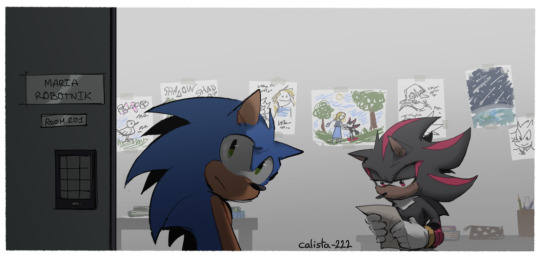
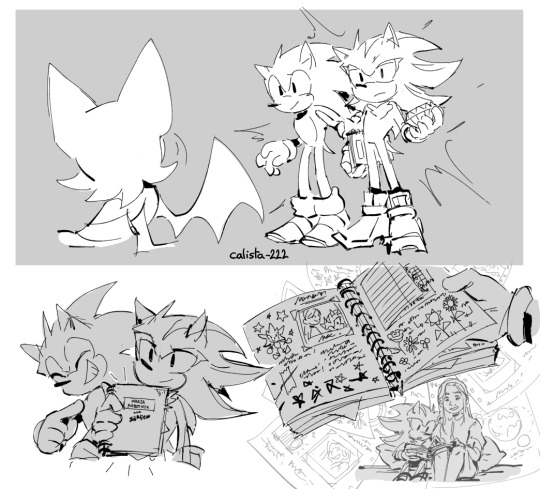
Bringing some happy memories home ✨
#my art#sonic#sth#sonic the hedgehog#space colony ARK#shadow the hedghog#rouge the bat#maria robotnik#sonic adventure 2#cw blood#why's sonic there? idk I like drawing him in every situation shhh#huh I colored him very light blue here
10K notes
·
View notes
Text
MON 29th JAN: Benin 'Bronzes'
Masterlist
BUY ME A COFFEE
Further reading: Annie E. Coombes, Reinventing Africa: Museums, Material Culture and Popular Imagination in Late Victorian and Edwardian England, ‘Material Culture at the Crossroads of Knowledge: The Case of the Benin “Bronzes”, 1994
Toby Green, A Fistful of Shells: West Africa from the Rise of the Slave Trade to the Age of Revolution, ‘Rivers of Cloth, Masks of Bronze: The Bights of Benin and Biafra’, 2019
More and Other

Building off artwork from around the world, art of Africa is rarely explored. Or when it is, it is mislabelled as being art when its purpose was something completely different. Or served as both.
The second part of our lesson consisted of looking at Benin Bronzes and going to The British Museum to look at them in person before the lesson. Now while it was beneficial to see them up close, it was hard to find and understand what you were looking at, especially without a reference point to the history.
These are examples of the Benin Bronzes:
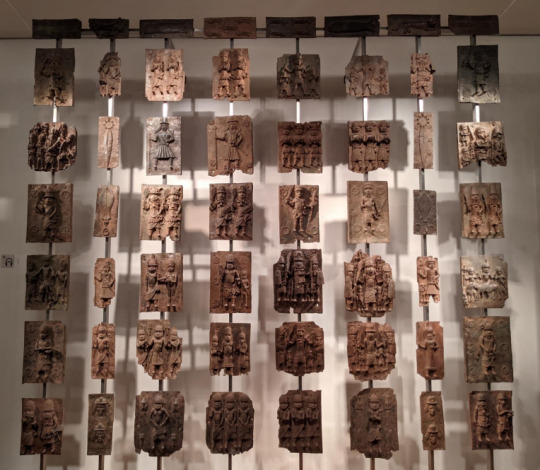
Resources linked to a 2019 exhibition about trans Saharan trade.
Looking closely at this piece specifically reveals hidden information to us about the Benin Bronzes, especially what they were used for and part of decoration on columns and panelling on roof. Historians love pictures in pictures as it reveals greater insight into purpose and time period.

A big question that comes up when discussing them is: Should they be returned?
Another question that comes from looking at them, and after tackling the previous question asked is: How do we reconstruct it? Is there a way to?
Bronze is a high statues object and material; these Bronzes were taken from a palace.
A comparison visually has been made to Ancient Egyptian art but there aren’t a lot of compelling references and links. Although there are records of artists travelling between these countries. How do we compare different cultural and societal developments?


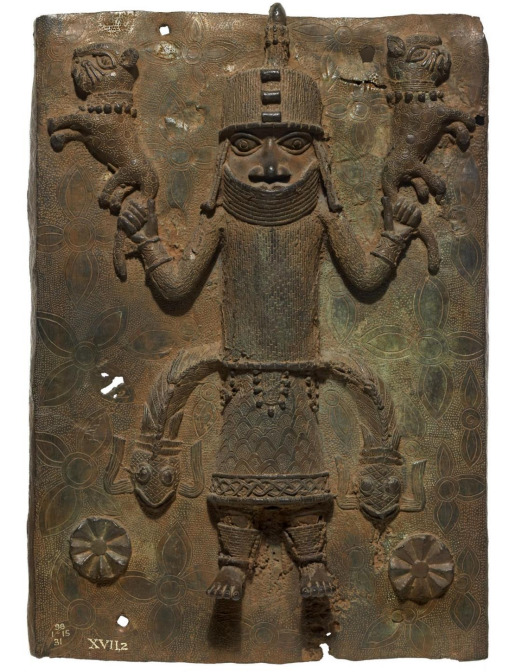
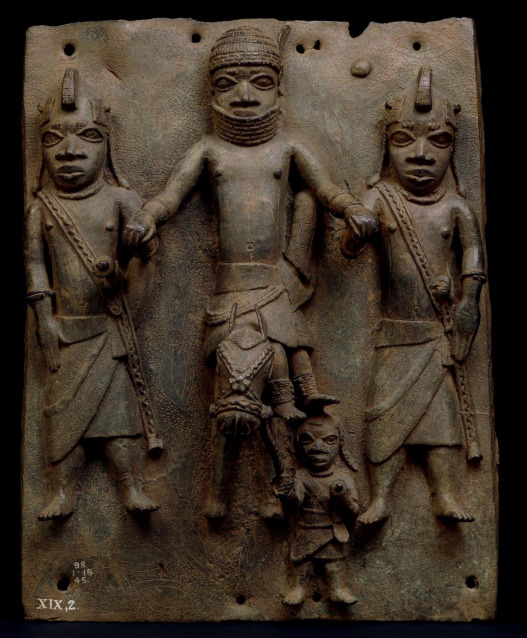


These Bronzes cannot be admired without discussing the deep-rooted colonial history that became part of them due to colonisation by the British Forces, and while this is a great point and history to them, the museum does a lot to make the Bronzes about the West and colonisation, rather than giving great details about the Bronzes and their purpose, and functionality etc.
While this may not be surprising to those more educated on the topic of colonisation/colonial power, an aspect that may terrify and surprise you, that our professor said he had an unfortunate encounter with a curator of the British Museum in the late 70’s saying proudly that “nothing that was in the Museum was stolen or acquired illegally due to those countries belonging to Britain”.
While this may have some merit, only in the fact that legality is flexible historically, when tackling historical artifacts. Which makes acquisition and keeping them complicated.
And while the British Museum has people advocating for it, that it’s educational…Well, I just wonder what the countries their stolen goods and artifacts come from have to study from and display for education or other.
A book on the topic of Museum perpetuating certain ideas and views: The Brutish Museums: The Benin Bronzes, Colonial Violence and Cultural Restitution, 2020 by Dan Hicks (an anthropologist)
Art History stands in a strange place when it comes to non-European art, as it is studied by Anthropologists and Ethnologists rather than Historians or even Art Historians.
Who are the artists we collect? And what do those artists represent and how do we perpetuate it?
While Anthropology museums can argue that they appreciate the culture and house it, it’s hard to defend a place like The British Museum (which I’m very much not going to do). I am an immigrant to England and we actually refer to The British Museum as the “Museum of stolen goods”, or “The British Empire Museum”.

"A photograph in an album in the National Army Museum, perhaps taken at Portsmouth or in London shortly after the return of some of the Benin soldiers, shows 45 soldiers and officers in blackface. They have raffia capes, wigs, clubs, staffs, spears, bows and arrows and drums, and one holds a skull aloft on a stick. In the foreground, the group look on while one of the ceremonial swords looted from Benin City is held to the back of the neck of a kneeling man, in a parody of human sacrifice. […] Benin was presented as ‘degenerate’.” (Hicks, 192)
Film theorist Bill Nichols argues that re-enactment ‘forfeits its indexical bond to the original event. It draws its fantasmatic power from this very fact’ (74). For Nichols, the re-enactment gains in force because of this lost bond. The ‘very act of retrieval’ does not retrieve the original event itself but rather ‘generates a new object’ (74). Nichols, Bill. ‘Documentary Reenactment and the Fantasmatic Subject’. Critical Inquiry, vol. 35, no. 1, 2008, pp. 72-89.
What might be the new object generated by this re-enactment in 1897? Perhaps some form of rebirth or rediscovery?

"Immediately after Benin forces ambushed and killed the Acting Consul-General Phillips and most of his entourage, the Illustrated London News of the 23 January 1897 published an article denouncing Benin society as having 'a native population ofgrovelling superstition and ignorance', together with an apparently unrelated photograph entitled 'A Native Chief and His Followers', showing a group of women sitting around the single figure of a man (fig. 3). The group of figures seem, from a contemporary European perspective, to be impassive and static. In the foreground, two women are literally arranged to frame the image. While the 'native chief' is the central figure compositionally, it is the women who predominate and who arrest the eye. The nudity of the foreground women is both masked and accentuated, because their objectification is reinforced by the fact that this is clearly not a natural posture. They have evidently been 'put' there. To cement this objectification, their bodies signify as the human equivalent of the 'trophy' display which was so popular at this time with both ethnographer and big-game hunter alike (fig. 4). This is a recurrent feature of representations, not only of the Edo but other African women, in the British illustrated press.” (Coombes, 12)

5.’Benin girls with aprons of Bells’, Rehquary, vol. VI (October 1900)
“a photograph in the Reliquary, a serious antiquarian publication with a readership of archaeologists, ethnographers and folklorists, employed the same motif ostensibly to illustrate bells on Benin women's girdles. The bells seem a rather precarious alibi for voyeurism since they are difficult, if not almost impossible, to make out. It is again the body which is actually held up for inspection. The 'scientific' aegis of the journal operated here in a specific way in relation to the image. Together with the same compositional framing device as the previous illustration, this photograph's additional status as 'document' rendered even more respectable such overt nudity and any sexual connotation implied, in much the same way that the familiar convention of mythologising the nude in western fine art supposedly masked the sexuality of the sitter sufficiently to render nudity inoffensive to bourgeois sensibilities.” (Coombes 12-13)
Images were often adapted, reproduced, replicated — thus circulating in several forms and in varying contexts. For example…

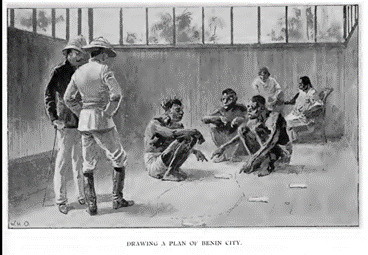
(Left) Joseph Holland Tringham, Chief Dore and Three Other Natives Drawing a Rough Plan of Benin City with Matches, Paper and Cork on the floor of the ViceConsulate, New Benin, before the Vice-Consul and Commander Bacon, engraving, published in the Illustrated London News (27 March 1897
(Right) “W.H.O.”, Drawing a Plan of Benin City, illustration in Commander R. H. Bacon, Benin the City of Blood (London and New York, 1897), p. 30.
Images in public circulation, e.g. in the illustrated press Are images constitutive or reflective? In other words: do they create new perceptions, or do they reveal existing ones?
Some quotes from the gallery
“Sainsbury African Galleries dedicated to Henry Moore OM CH”
“early Western accounts of Benin and the size and splendour of its capital, Benin City, were highly favourable. However, as Western interests encroached on the area in the late 19th century, Benin was increasingly depicted as a place of oppression and human sacrifice.”
“When the British attacked Benin City in 1897, the plaques were found in a storehouse, having been previously removed from the palace walls.”

Interior of the Royal Palace during looting, showing Captain Charles. Herbert Philip Carter, ‘E.P. Hill,’ and an unnamed man in February 1897. Pitt Rivers Museum, accession number 1998.208.15.11
“The Benin plaque is no mere work of art but rather the residue of a vast cultural experience that is now decontextualized. It was removed from its proper place in the aftermath of a mass killing, amid the stench of human bodies. It emerged from a landscape with a burning city. To describe it was being part of the “Robert Owen Lehman Collection”—to center its history on its having been purchased at auction by a wealthy American—is to suppress the plain truth of why such a thing is in other people’s keeping. To speak even of a ‘punitive expedition’, as is commonly done in the literature on Benin, is to accept the British version: that vengeance for the deaths of five or seven white men justified the destruction of the life-worlds of hundreds of thousands of people. It is to tacitly accept that the mission to ‘civilize’ Benin was worth the destruction of Benin’s civilization and the mass murder of its people. […] We know not to touch objects in museums. We are all obsessed with preservation and we revere scholarship and curation. But we have not been concurrently taught to value the life-worlds of others, their autonomy, their ancestral rights. Particularly if the people in question are from the African continent, their ingenuity can be appreciated, their artifacts can be acquired and subjected to analysis, but their actual lives cannot be valued. What does it mean to care about art but not about the people who made that art?” Teju Cole, Tremors (2023) — in which the narrator is speaking about the Benin “Bronzes” in the Museum of Fine Arts, Boston
#art#art gallery#artwork#writing#art tag#essay#paintings#art exhibition#art show#art history#colonial violence#colonization#colonialism#artists#history lesson#historical#history#world building#world#world politics#words#essay writing#writers#writeblr#writers and poets#drawings#lecture#dark academia#colonial history#colonial art
0 notes
Text




Watercolour illustrations of Tasmanian fish by English convict painter William Buelow Gould (1803-1853).
In the State Library of Tasmania
1 note
·
View note
Text


#feminist#feminism#social justice#free palestine#freepalastine🇵🇸#palestine#free gaza#settler violence#settler colonialism#palestinian art#palestinian artist#we stand with palestine#art#end the occupation#end the genocide#ceasefire now#ceasefire
12K notes
·
View notes
Text

🇵🇸🇵🇸🇵🇸
please, keep talking about Palestine. Especially during the holidays. keep calling and keep protesting. make every life lost unignorable.
#palestine#free palestine#free gaza#art#artists against apartheid#free sudan as well and the congo and haiti#we will see an end to the colonial monster in our lifetime. we have to#star's art#i have/had something bigger planned to post but i'm traveling for the holidays and can't finish it yet
8K notes
·
View notes
Photo
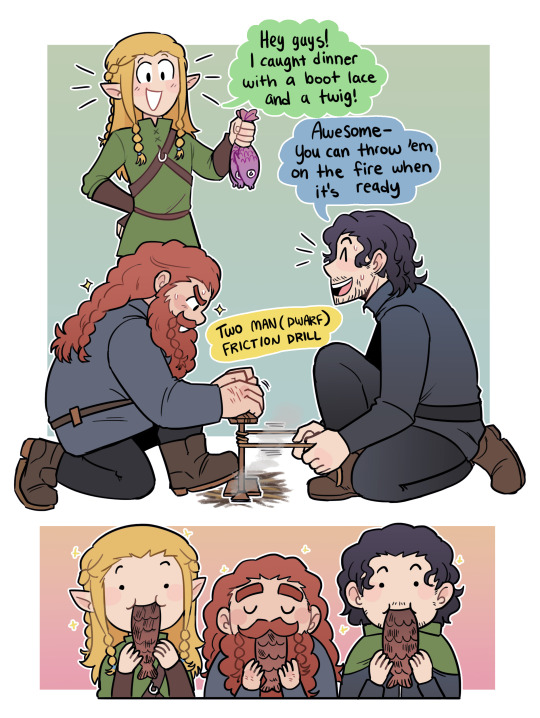
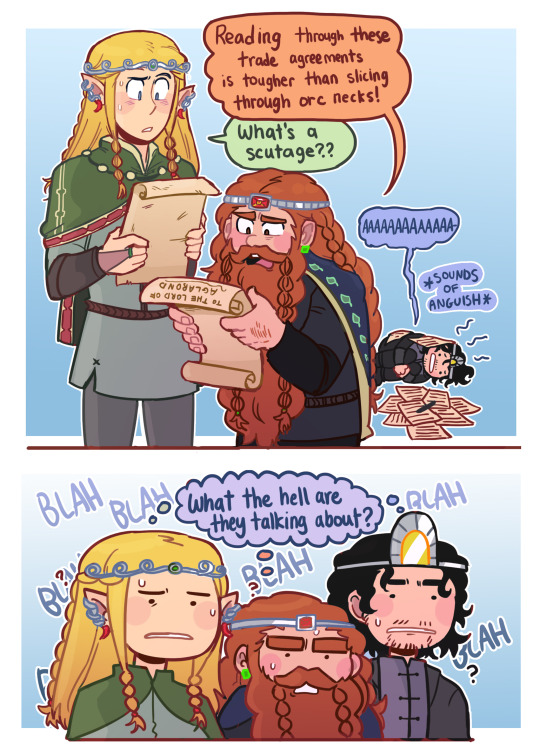
more three hunters stuff cuz i love them
#the idea that these gremlins become kings and lords is so funny#legolas eats dirt and you want him to found a colony????#lotr#legolas#gimli#aragorn#lord of the rings#my art
8K notes
·
View notes
Text
For #WorldNumbatDay:
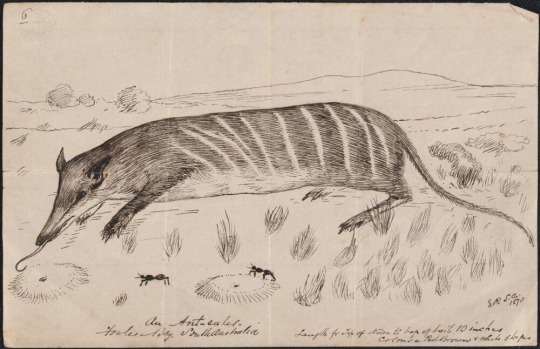
"An ant-eater, Fowlers Bay, South Australia" by Edward Russell, 1870
pen & ink, 11.4 x 17.8 cm
inscription: "Length fr. top of nose to top of tail 10 inches, colour a red brown & white stripes."
National Library of Australia
#animals in art#animal holiday#illustration#numbat#World Numbat Day#drawing#Edward Russell#marsupial#Australian art#colonial art#Australian animals#Australian wildlife#19th century art#National Library of Australia
184 notes
·
View notes
Photo
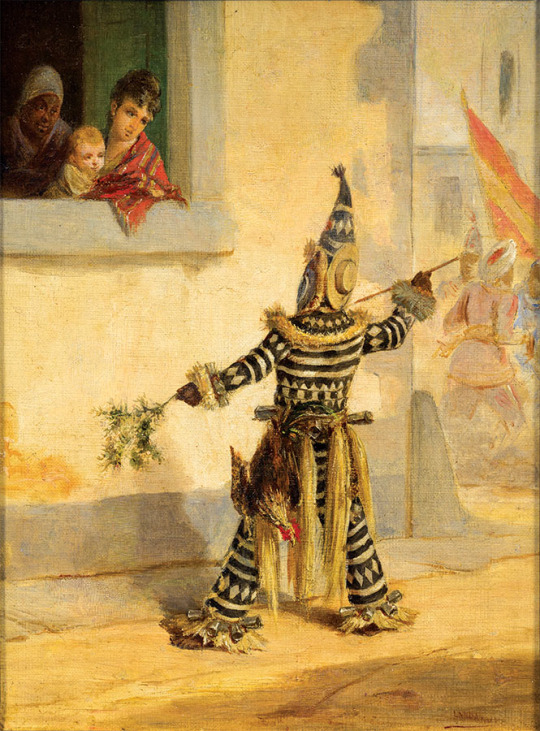
Víctor Patricio de Landaluze (Spanish-born active in Cuba, 1830 - 1889)
Diablito, 1800s
Museo Nacional de Bellas Artes de Cuba
In Diablito... we see a scene from Día de Reyes en La Habana, the only day of the year that Havana slaves are allowed to parade before the Governor.
#victor patricio de landaluze#Víctor Patricio Landaluze#spanish art#spanish#spain#fine art#fine arts#diablito#1800s#art#beautiful art#cuba#cuban art#cuban#cubana#colonial art#colonial#world history#oil painting#traditional art#western civilization#spanish woman#woman and child#black history month
101 notes
·
View notes
Text

putting pressure on elected officials works. let's keep up the pressure to #CeasefireNOW and end the genocide.
Digital illustration of an upset asian woman with long curly hair. She is wearing a striped wrap dress and holding a dove. There's text that reads, 'keep up the pressure, end the genocide.'
1K notes
·
View notes
Text



Vajra Chandrasekera is a Locus and Nebula award-winner and has been short-listed for a Hugo Award this year. You can find his Tumblr here: @adamantine and his twitter here: @_vajra
#capitalism#ableism#sexism#anti blackness#colonialism#racism#colonial capitalism#colonial violence#imperialism#poverty#global south#elitism#classism#western imperialism#colonization#gaza writes back#vajra chandrasekera#saint of bright doors#rakesfall#science fiction#genius#art#writing#literature#social justice#individualism#twitter thread#knee of huss#inequality#misogyny
5K notes
·
View notes
Text


Petit Manan Lighthouse, Petit Manan Island, Steuben. Possibly my favorite lighthouse. In the summer, this island is home to hundreds of birds. Including Atlantic puffins, arctic, common and roseate terns, as well as black guillemots and many more. Decided I couldn't draw them all, but here's a couple attempts to try and capture the island's vibes. Can you spot the oystercatchers?
MERCH
#Petit Manan#Petit Manan Island#Petit Manan Light#Petit Manan Lighthouse#Steuben#Maine#Lighthouse#light#island#Maine island#art#illustration#design#sticker#National Wildlife Refuge#Maine Coastal Islands National Wildlife Refuge#Maine Coastal Islands#breeding colony#terns#tern colony#puffin#Atlantic puffin#black guillemot#sea birds#sea bird#arctic tern#flying#in flight#bird#birds
2K notes
·
View notes
